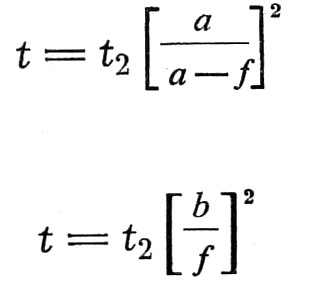Macro exposure.
For macro shots or too, how else can you say, close-up photos of items are depicted ,not as in normal cases strongly reduced, and only in a slight reduction or a slight enlargement. The light reflected from the object must therefore expose a much larger negative plane in macro photos, and then with the same aperture the image is less illuminated. If, for example, we are photographing a bouquet of flowers from a distance 2 meters at 1/10 seconds, and if with a close photo, with the same aperture and lamp setting, we will approach with the camera like this, the chosen flower, which was previously large 1 mm², will now take a plane 10 mm², to obtain the same optical density of the image it must be exposed 10 times longer, and so 1 sek.
Generally we know the exposure time for new, different shooting conditions with the same brightness of the object, calculate according to the following formula:

Where:
t - search for new exposure time,
t1 - known exposure time,
a - new object-to-lens distance,
a1 - long object distance, corresponding to time t1,
B - new aperture value,
B1 - Aperture value predetermined at time t1,
ƒ - focal length of the lens.
If we leave the aperture unchanged, and as a comparison, we will choose the attitude at a long object distance (more than 10 times the focal length), so that under these conditions the light meter readings will still be correct, the simplified formula will look like this:

Where:
t2 - known exposure time, at a long object distance,
b - image distance (= camera lift) with a new photo, other markings as above.
So we use the exposure time values read on the light meter or we assume the same exposure times, as known from earlier photos, placed in square brackets and thus we arrive at the correct exposure time. However, if we move the lamps together with the camera, then we should first point the light meter again in the direction of the camera, to determine, how the lighting has changed to take this factor into account as well, because the previous lighting conditions may have changed very significantly. The extension of the exposure time calculated according to the above formulas may be compensated if necessary, if we move the lamps together with the camera.